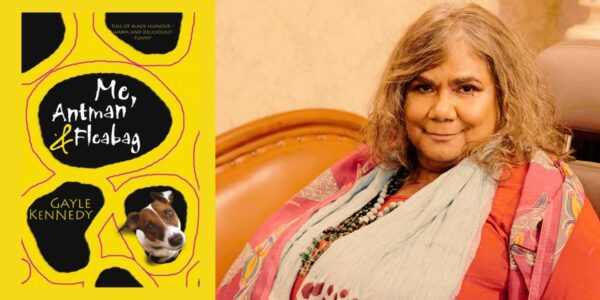In our Spotlight On series, we chat with a member of the Writing NSW community to celebrate their success and learn more about their writing practice. This month we put the spotlight on writer, editor, and poet Gayle Kennedy. Gayle spoke with August and Blake from Writing NSW about her award-winning book Me, Antman & Fleabag – a First Nations classic about contemporary Indigenous life told with wicked black humour, depth, and charm.

Congratulations on getting your book Me, Antman, and Fleabag published in the UQP’s First Nations Classics series. What defines a “First Nations classic” to you?
A book that lasts and one that can be read across generations, cultures and all ages.
Which books would you include in your personal First Nations classics list?
Don’t Take your Love to Town by By Ruby Ginibi, and Rabbit Proof Fence by Doris Pilkington as both perfectly capture the mores of the time. Alive and visceral, full of the sights and sounds, the heartaches and the joy of these two lives. Lives that could have been little lives long forgotten now loom large on the national and international. Consciousness because of these two authors. They showed that policies aren’t pieces of paper, they are people’s lives and the effects are still being felt today.
Readers love Me, Antman and Fleabag for its “quirky characters” and “wickedly funny” anecdotes while tackling serious topics like ostracism, racism and disability. What significance does the use of humour have in your storytelling?
Humour is very much a part of me. I come from a family of storytellers, yarn spinners and people that laugh a lot. We had nothing materially but there was so much love and piss taking and raucous laughter. I wanted to capture some of that but without losing the underlying seriousness of some of the stories. My book is designed for people to discover truth but ultimately, the book belongs to readers and they can choose how they interpret it.
Besides works of literary fiction such as Me, Antman and Fleabag, you have published poetry, children’s novels, comics, and news articles. How has this diversity in genres shaped your writing?
The life of a writer is precarious so it’s diversify or watch your career go down the gurgler. Some people manage to write best sellers and make a quid but for the rest of us we take on genres, public speaking, fiction and non fiction, articles, research etc in order to pay the rent. I had to learn on the run. I can now confidently take on any commissions or offer of work or pitch to magazines etc in order to continue my life as an author.
You have spoken nationally and internationally on your experience with disability. How does your book highlight the culturally distinct experience of disability for Aboriginal people, and Aboriginal women in particular?
Disability doesn’t figure much at all. Apart from one story ‘Me and Antman Hook Up’ where disability and physical damage are examined through the prism of their relationship. The main aim of the book was twofold, one to give people a window into our world and another to give Black Men back their power.
You write with a very unique voice that differs from the conventional English literary language. How is this style of expression important to your work?
It was the only way the book would work for me. It had to be told in the lingo. Many people told me it was too risky, that I risked alienating potential readers but I had just read the Mayor of Casterbridge by Thomas Hardy, written in the vernacular, and it was liberating for me. It gave me permission if you will, to do the same. ‘Good enough for Hardy, good enough for me’ as they say in the classics. My book has a rhythm and a sense of place that it wouldn’t have had if conventional English were used.
Me, Antman and Fleabag isn’t a conventional novella, but a collection of 22 short, shared stories. How did you tie together these different narratives into a larger thematic piece?
The book started life as a winning entry in the NSW Writer’s Centre’s Inner City Life competition. The story was called How Ta Drink in the Park where I examined the different rules for Black and White. It eventually became the first chapter of the book. I liked the characters so much I started sending them off on road trips, adventures that became a novel. It was called an interlinked narrative. Really though it was a happy accident. Serendipity if you will.
Gayle Kennedy is a member of the Wongaiibon Clan of NSW and was the Indigenous Issues editor and writer for Streetwise Comics from 1995-1998. In 2005 her poetry manuscript ‘Koori Girl Goes Shoppin” was shortlisted for the David Unaipon Award, and in 2006 she won the David Unaipon Award for Me, Antman & Fleabag, which was shortlisted for a Victorian Premier’s Literary Award, a Deadly Award and was commended in the Kate Challis RAKA Award. Gayle has published eleven children’s books as part of the Yarning Strong (OUP) series, and six of these were nominated for the 2011 Deadly Award for Achievement in Literature.
Gayle runs writing workshops and has presented at writers festivals, schools and NAIDOC events, and has spoken nationally and internationally on her experience with disability. She was commissioned by Red Room Poetry to write a poem for the Carved Trees Exhibition at the State Library of NSW.
Read more about Gayle here and Me, Antman & Fleabag here.
Here’s where you can read more Spotlight On.
